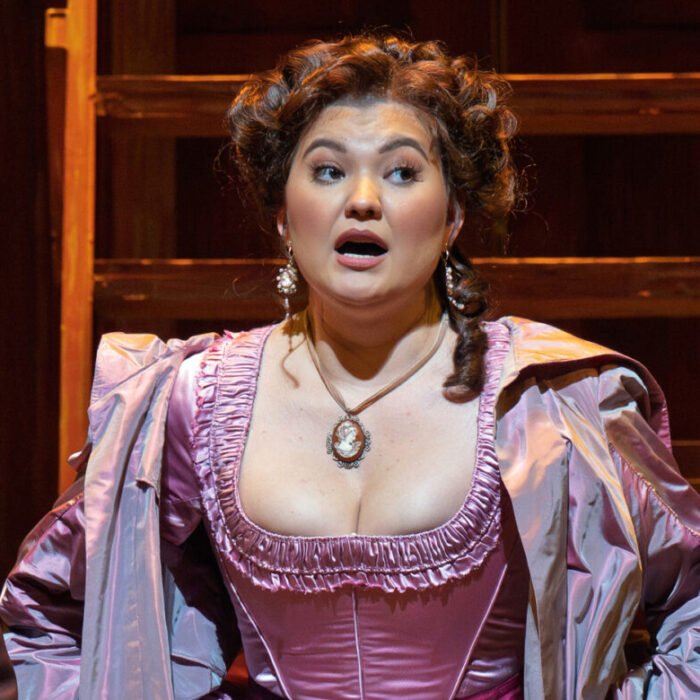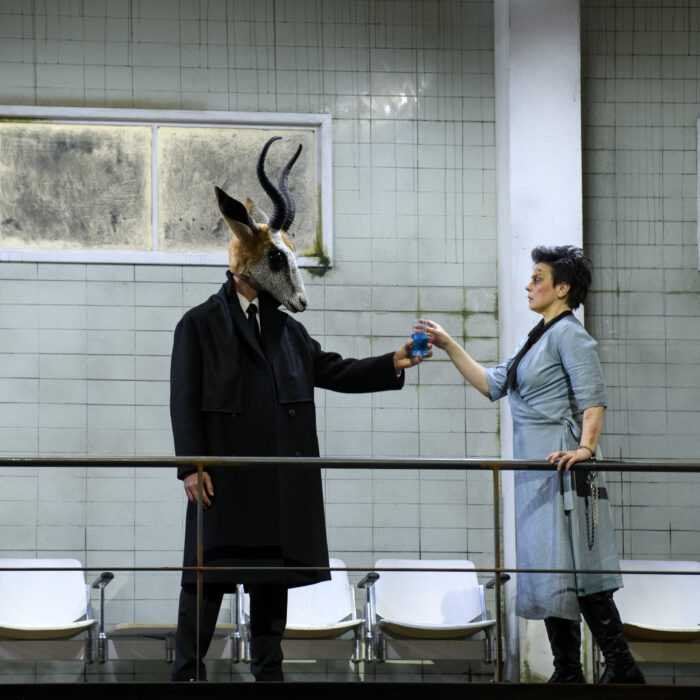
Oper Frankfurt 2019-20 Review: Otello
Michieletto’s Direction Strengthens Rossini’s Flawed Drama And Allows The Music To Shine
By Alan Neilson(Photo: Barbara Aumueller)
“They have been crucifying our Othello into an opera,” was Lord Byron’s reaction on seeing a production of Rossini’s “Otello,” continuing “Music good, but as for the words… …and the greatest nonsense instead.” Even Stendhal, a keen supporter of the composer, was angered by the work, suggesting that his music should be reset to Shakespeare’s text. The libretto was written by Francesco Maria Berio, who even if he kept to the basic storyline, was clearly more concerned with fitting the narrative to the dramatic and musical conventions of early 19th century Italian opera, at least for the first two acts, rather than remaining true to the dramatic intentions of Shakespeare: out went Cassio, Iago became a subsidiary character and Rodrigo is elevated to a major player, although notably, he kept its tragic ending, and in doing so he helped move opera into the Romantic age. It is only in Act three, that the text is able to get anywhere near to the brilliance of Shakespeare’s drama, and to which Rossini was able to respond with music of greater dramatic intensity and nuance. Nevertheless, it was to remain popular with the public for much of the century before being swept aside by Verdi’s superior version.
A Ingenious Production
The approach of the director, Damiano Michieletto, was to tackle the weaknesses head-on by changing the relationship between the characters, their interactions, motivations, and the setting of the opera, in order to alter the dramatic dynamics and give the musical structures a more immediate impact. This is tale of two influential families who want to concentrate their power through a marriage between Desdemona, daughter of a powerful Venetian politician, and Rodrigo, the son of the rich businessman, Emilio. Unfortunately, this plan is doomed to failure because she is already secretly married to Otello, an Arab businessman. Emilia, Desdemona’s maid, is now her sister and wants to marry Rodrigo herself, and is therefore not at all well-disposed towards Desdemona. Iago, a secondary character, is restored to prominence as Desdemona’s cousin. His presence becomes pervasive, appearing at significant moments, to manipulate events, achieved through symbolic mime and silent confrontation. Even though he sings much less than either Rodrigo and Otello, his status has parity and brings a vicious edge to the drama. Michieletto used the musical set pieces, which can be static affairs, to push Iago to the forefront. In the quintet and stretta finale of Act one, for example, rather than having the cast singing standing rigidly facing the audience, Iago daubs Otello with grey slime, causing the rest of the cast to do the same to each other: hatred is a contagion from which no one is immune!
He also cleverly shifted the meaning of the text by having it aimed towards a different person from that originally intended, so that Desdemona may start a conversation speaking to Emila, but shifts so that her words are directed towards her father, successfully altering the relationships between the protagonists.
Michieletto added further interest to what would have been static scenes through the introduction of symbolic characters who interacted with the cast. On the wall of the drawing-room hung a large picture of Francesca di Rimini and her lover Paolo. Francesca was forced into a political loveless marriage and began an affair with her husband’s brother. When they were discovered, he murdered them. Symbolically the meaning is clear, but Michieletto had them take physical form and enter the room at significant moments, creating interesting juxtapositions with Otello and Desdemona, as well as adding to the scene visually.
The scenery, designed by Paolo Fantin, consisting of marbled offices, ballrooms, and dining rooms, and the costumes designed by Carla Teti, captured the world of big business and politics, money and power. Significantly, Otello was well-dressed in Western attire, signifying his desire to be included, but his turban set him apart from the rest, as the outsider.
In fact, this was a reinterpretation of the narrative which very much highlighted contemporary themes, with racism at its center; The Doge is more than happy to proclaim Otello’s glory in the public sphere, but it is a far different matter when Otello voices his love for his daughter. Likewise, the people are happy to sing the praises of his business successes, but are horrified by him covering Desdemona’s head in a scarf, its allusion to the burka all too obvious. Iago, in particular, is wise to Otello’s desires and his alien culture and seeks to destroy him, although his hatred, unsurprisingly, was not confined to Otello.
It was a hugely successful staging in that it completely changed the nature of the static first two acts into dramatically engaging and fast-moving scenes, which moved seamlessly into the murderous final act, and provided balance to what would have otherwise been a lopsided drama.
An Impressive Cast
The musical side of the production was led by the conductor, Sesto Quatrini, who produced a fine performance from the orchestra and elicited some excellent singing from the cast. Although the orchestra was a little heavy and sluggish at the very beginning Quatrini quickly brought it under his control and delivered the typical Rossini sound with its sharp attack, rapidity and rhythmic vitality, but was careful to mould it to the work’s dramatic requirements, so that its darker elements were given their full prominence, in order to create the requisite contrasts. He was also attentive to the singer’s needs, resulting in a well-balanced and pleasing presentation.
The role of Desdemona was undertaken by soprano, Nino Machaidze, who gave an expressive and powerfully sung reading. Under constant pressure from all quarters, Machaidze portrayed Desdemona as a victim of the competing agendas of Otello, Rodrigo, Iago, Emilia, and her father, and who unable to break free from their conflicting demands is finally murdered by Otello. Her rendition of the “Willow Song,” contained more emotional and dramatic force than is the norm, as she teetered on the brink of semi-madness. It was a forceful reading, predicated on her strong vocal qualities: agility, beauty, strength, technical surety and an ability to inflect the vocal line with nuanced meaning. Her coloratura was strong and she moved between registers freely and without any loss of quality, in what was a persuasive and strongly defined performance, delivered with confidence.
One of the unusual features of the work is that the three principal male roles are all for tenors. This is not a result of artistic considerations, but rather because the Teatro del Fondo, Naples, which premiered the work in 1816, had three tenors available. The result is an unusual soundscape, which at times lacks contrast and textural variety, which is particularly noticeable in its ensemble pieces. The three tenors cast for this production by Oper Frankfurt were sufficiently distinct, however, to sustain interest.
In the title role was Enea Scala, whose voice has an innate beauty well-suited to the bel canto repertoire. His full-bodied tenor is warm and colorful. He sings with a great deal of agility, although there is a little thinning of the voice as he pushes into the upper register. His phrasing is firmly grounded and wonderfully expressive, and his enunciation of the text was excellent; it was clear, strong and littered with emotional inflections. He brought depth and insight to the role, catching the ebb and flow of Otello’s emotional instability, in what was an expressively, compelling and purposeful presentation. Moreover, Scala looked every inch the sophisticated Arab businessman and produced a superb acting performance in which his confident swagger at the beginning unwound as, surrounded by intolerance and Iago’s machinations, he became increasingly aware of his position as an outsider, which allowed his jealousy and desire to kill to thrive.
Jack Swanson made a great splash in the role of Rodrigo and deservedly received sustained applause at the final curtain. A tenore di grazia with a pleasing upper register, and without the reedy sound which often sounds too thin and forced, Swanson showed real quality. His voice danced its way through the part, taking leaps in his stride, and making light of the role’s high tessitura, which was beautifully displayed in the cabaletta, “Ah! come mai non senti,” He was also attentive to characterization, making use of his vocal versatility and strength. He played Rodrigo as a fairly weak character, reacting to Desdemona, Otello, his father or Iago, rather than determining the nature and direction of the relationships. He also had a homoerotic attachment to Iago, which Iago was happy to exploit.
The third tenor, Theo Lebow, was cast in the role of Iago, which although given greater prominence in this production, is, in essence, a secondary role, with fewer singing opportunities than Otello or Rodrigo, and doesn’t have an aria. Lebow produced a solid singing performance, in which his voice displayed flexibility and an attractive tone, and sang well in the duets. His Iago was more than a simple psychopath, he was far more unstable, impulsive, delusional and exhibited too little control to simply hide in the shadows and coldly manipulate. It was a convincing portrayal, although it is likely he would have been quickly identified for the maniac he was in the real world.
There were also a couple more tenors in minor roles which did little to add to the textural variety. Lucio, the family doctor, played by Michael Petrucelli, who as a member of Frankfurt Opera Studio impressed in the small role, displaying a well-supported voice with an attractive timbre. In the role of the Doge was Hans-Jurgen Lazar. He portrayed his character in a wheelchair, who as a result of his daughter’s independent spirit and recalcitrance developed breathing problems and looked as if he were heading towards the grave. He gave a convincing performance, his singing deliberately becoming increasingly shaky and unstable as events unfolded.
Also from the Frankfurt Opera Studio was soprano, Kelsey Lauritano, who was impressive in the role of Emilia, whom she portrayed as a happy-go-lucky, spoiled young woman, uninterested in her sister’s happiness and determined to marry Rodrigo; Desdemona’s death did not trouble her at all! She possesses a fresh, vibrant soprano and sang with a confidence and an openness that could not help but attract. One of the more fetchingly sung numbers was her duet with Desdemona, “Vorrei, che il tuo pensiero,” in which her voice combined with Machaidze’s to produce an engaging and pleasing result.
Thomas Faulkner, playing the role of the rich industrialist, Elmiro, cut an imposing figure, both physically and vocally. His large frame and strong bass allowed him to command the stage, perfectly reflecting his lofty status. Although he has a big voice it is also very flexible, which enabled him to produce a nuanced performance that captured his happiness, anger, rage, and frustrations.
Overall, this was a production of a work which rarely receives the credit it deserves owing to its dramatic flaws and, of course, the inevitable comparisons that are made to Verdi’s and Shakespeare’s superior versions. However, thanks to Michieletto’s imaginative direction its dramatic shortcomings were successfully dealt with, and under the firm control of Quatrini, together with some splendid singing from an accomplished cast, allowed Rossini’s music to shine.
Categories
Stage Reviews


